Belarus Tour Guide: Ideas for Your Trip!
Rechitsa landmarks: A metal chapel on the bank of the Dnieper, an oil museum and paintings by Belarus’ most mysterious artist
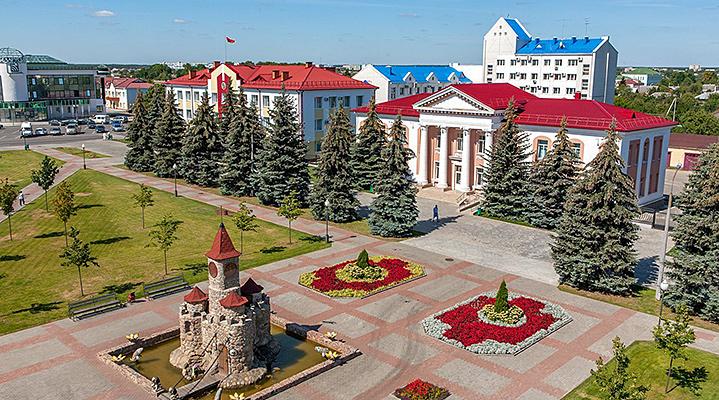
The town of Rechitsa – the center of Belarus’ oil industry – stands on the banks of the dignified Dnieper River. Rechitsa was first mentioned in the Hustyn Chronicle in 1213. The Novgorod Chronicle mentions the capture of the town by Prince Mstislav Mstislavich Udatny in 1214 during the war with Kiev Prince Vsevolod Svyatoslavich.
Rechitsa owes its name to the eponymous tributary of the Dnieper, which flowed near the ancient settlement. Excavations suggest that people lived here as early as the 5th-7th centuries. Scientists believe that Rechitsa was a town already in the 11th century. Due to its location, the settlement served as one of the transit points on the trade route from the Varangians to the Greeks.
For a long time, the town was owned alternately by Kiev or Chernigov princes. In the first half of the 14th century Rechitsa was incorporated by Grand Duke Hiedymin into the Grand Duchy of Lithuania. For more than two centuries, the town was the administrative center of the district. After the First Partition of the Polish-Lithuanian Commonwealth in 1772, Rechitsa lost its status of the district capital (it went to Bobruisk). In 1793 it became part of the Russian Empire. In 1926, Gomel Oblast made part of the BSSR, and Rechitsa’s status of the district center was re-instituted.
The discovery of oil deposits in August 1964 was a pivotal point not only for the town, but also for the entire country. In late April 1965 the Druzhba pipeline pumped the first oil produced near Rechitsa. Since then, more than 138 million tonnes of oil and almost 16 billion cubic meters of associated petroleum gas have been extracted in the area of the Pripyat Trough, the country’s oil basin.
Today Rechitsa has a population of more than 66,000 and a title of Belarus’ oil capital.
Settlement
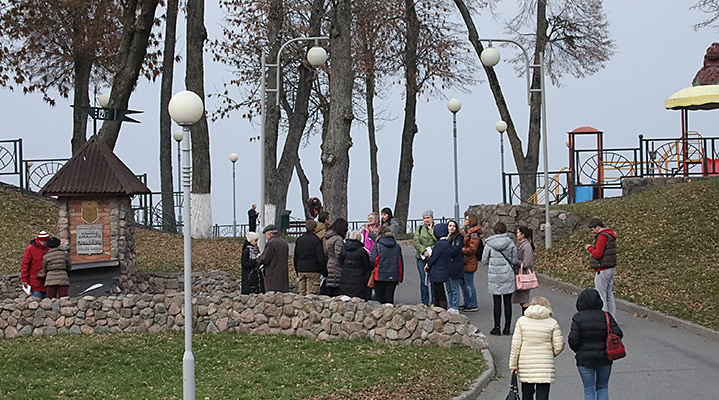
Like any medieval town, Rechitsa had its own fortifications. An ancient settlement stands on the right bank of the Dnieper, at the confluence with the Rechitsa River. This is a rectangular area 75x45 m. The castle hill is fortified with almost two-meter ramparts and protected by a natural water barrier - the Dnieper - from the north. There are deep ditches on both sides, they used to be filled with water.
At the end of the 14th century, when the town belonged to Duke Vitaut, a 5-tower castle was built from ‘pine wood’. The citadel performed its defensive functions for more than two centuries until it was burned down by the Cossack troops of Hetman Ivan Zolotarenko in 1654.
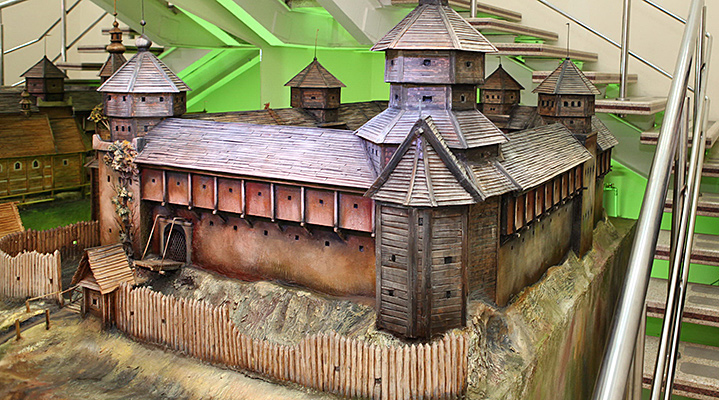
The history of the castle hill itself dates back to the times of Kievan Rus. Today the settlement has the status of an archaeological specimen and is under state protection.
Where: Children’s Park
Holy Trinity Church
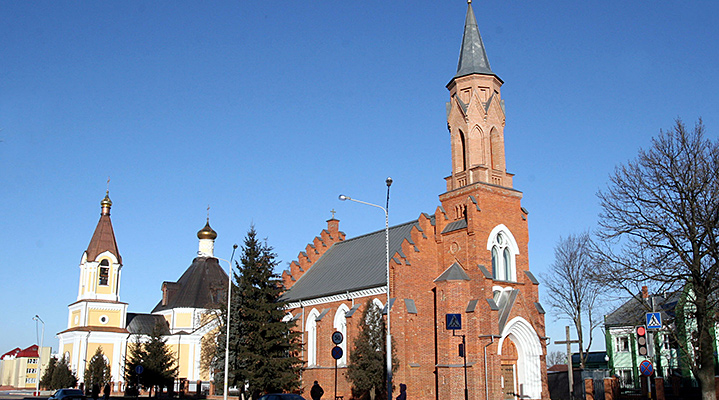
The Holy Trinity Church is located not far from the ancient settlement. This bright specimen of Neo-Gothic architecture was built at the very beginning of the 20th century - in 1903.
At the same time, the history of the church began in 1634, when the first Catholic parish was opened in the town. In 1756, a new church from pine was built here and consecrated in honor of the Holy Trinity, and a Dominican monastery opened. At the beginning of the 19th century, the monastery numbered almost two dozen monks.
The monastery was closed in 1831. It suffered the fate of many churches and monasteries on the Belarusian lands. The wooden church began to deteriorate and required either major repairs or demolition. In 1842, parishioners submitted a request for the construction of a brick church on the site of the existing one. Yet, the matter progressed slowly. Only by 1861 the design project was made, but due to the lack of money the construction was put on hold. Construction resumed only 35 years later and lasted for seven years.
During the Soviet period, the church in Rechitsa was more lucky compared to many Catholic and Orthodox churches in the country. It was not destroyed, although it was not used for its intended purpose. At different times the church was used as a warehouse, a power plant, a beer hall, a vitamin bar... After Belarus gained independence, the building received the status of an architectural monument in 1998. A year later, it was returned to the believers, reconstructed, and in 2007 resumed services.
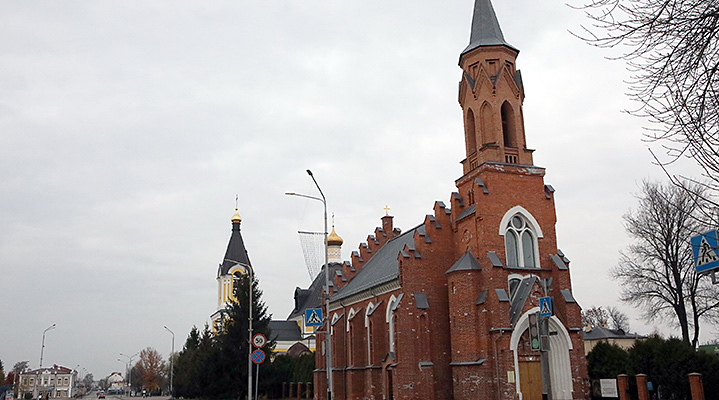
Today the Holy Trinity Church is one of the main landmarks of Rechitsa. The red brick has a strict integral plasticity. The church stands on a high plinth, the side walls are separated by buttresses and Gothic windows, which gives the temple a sense of rhythm. The front side is decorated with a white perspective portal. The belfry is massive, high.
Where: 31 Sovetskaya Street
Holy Assumption Cathedral
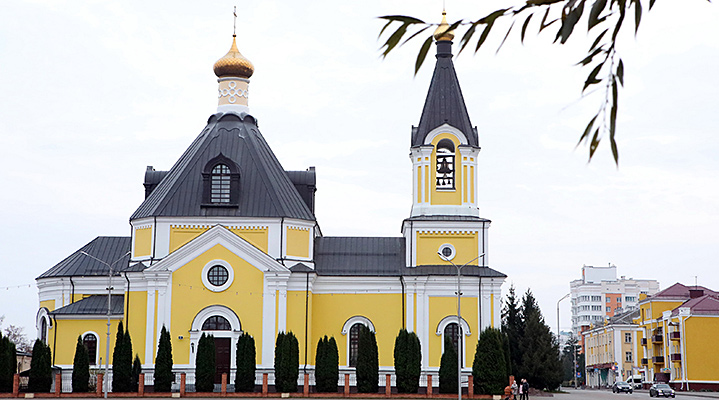
Very close to the Holy Trinity Church there stands the main Orthodox church of Rechitsa - the Holy Assumption Cathedral, which is one of the oldest buildings in the town. Its fate was not easy. Construction began in 1842 but had a bad start - a year later the bell tower suddenly collapsed. The almost finished building crumbled almost to the ground. Construction resumed only two decades later, in 1864. Thirty years after the beginning of the construction, the new temple was finally consecrated.
Since 1917, the clergy in Rechitsa was gradually liquidated. Seventeen years later the cathedral was closed and the most valuable church utensils were seized. Later, the church was used as the House of Socialist Culture. The belfry and the dome were demolished, the interior was completely changed, and an upper floor was added to host a community library. In 1940, the complex suffered serious damage during a fire. The following year, the local flock made repairs and the church resumed services. In the 1960s, the Rechitsa House of Culture was moved to a new building. The abandoned cathedral began to decay.
At the very end of the 20th century the building was returned to the Orthodox church. Restoration began, and the renovated Holy Assumption Cathedral was consecrated in 2003. The bell tower was restored in 2007.

Architecturally, the cathedral is a specimen of late Classicism. The temple has the shape of a cross. At the heart there is a prayer hall covered by the dome and roof windows. The pride of the Holy Assumption Cathedral is a five-tiered iconostasis consisting of 24 icons. In 2011, the church received two icon cases for St. Nicholas the Wonderworker and the Kazan Mother of God icons.
Where: 29 Sovetskaya Street
Chapel of St. Euphrosyne of Polotsk
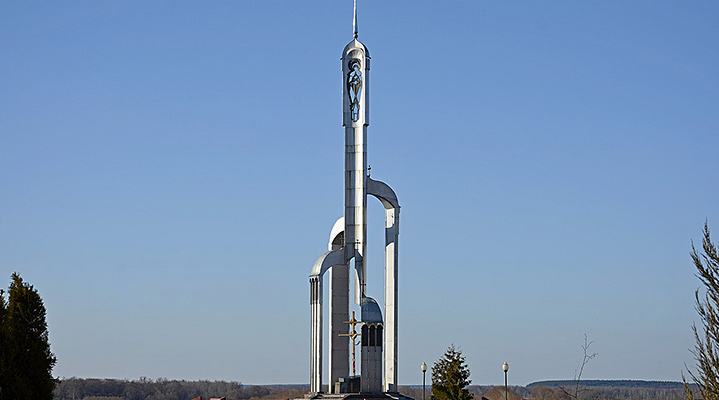
The Chapel of St. Euphrosyne of Polotsk is the dominant feature of the Dnieper embankment and one of the most recognizable landmarks of Rechitsa. Initially it was called Yubileinaya, as the monument was dedicated to several landmark dates - the 1000th anniversary of Baptism of Rus and the 50th anniversary of Victory in Great Patriotic War. The chapel was also built to honor peacekeeping soldiers, victims of the Chernobyl accident. People, however, named the chapel after the legendary Belarusian saint.
The place for the chapel was not a random choice. In 1910 the steamboats carried the relics of St. Euphrosyne, the heavenly protector of Belarus, from Kiev to native Polotsk along the Dnieper River through Rechitsa. The reliquary with the holy remains was brought onto the shore. Then the coffin was taken to the Holy Assumption Cathedral. The next morning the relics were returned to the steamboat. An oak cross was placed on the bank of the river where the steamboats with the sacred cargo were moored. Much later, in 1995, a memorial chapel was built there.
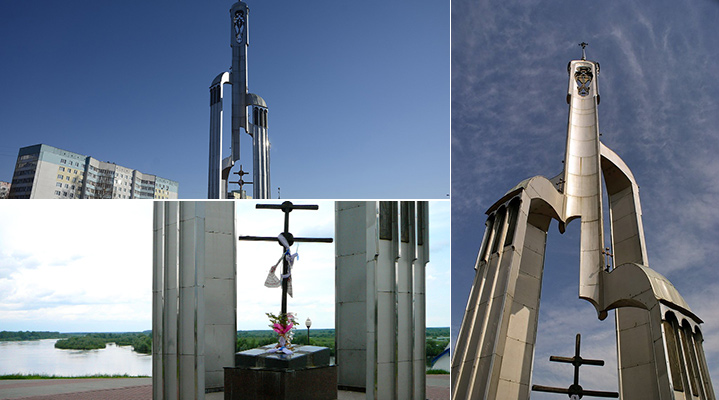
The chapel has an unusual asymmetrical form. Made entirely of metal, the chapel is 24.24 meters tall. According to designer Eduard Agunovich, the composition of four supports different in height shows symbolically how life and thought develop in a spiral. The walls bear images of 12 revered saints and great enlighteners of the Belarusian land. They are bishop of Polotsk Mina, bishop of Polotsk Dianisy, Cyril of Turov and Elisey of Lavryshevsk, Simon Budny, Vasily Tyapinsky, Simeon of Polotsk, Lev Sapega, Gavriil of Bialystok, Francysk Skaryna and Ivan Fedorov canonized both by the Orthodox and Catholic churches. The figure of Euphrosyne of Polotsk with the famous cross in her hands is located at the very top of the chapel. A wooden cross is on the ground between the supports.
Where: The intersection of Naberezhnaya Street and Chapayeva Street
Monument to Mitrofan Dovnar-Zapolsky
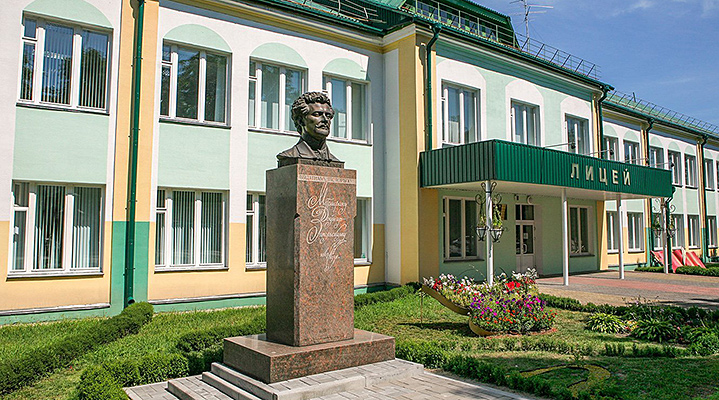
Rechitsa is the birthplace of outstanding historian and ethnographer, the “father” of Belarusian historiography Mitrofan Dovnar-Zapolsky. He set out to prove that the Belarusians were a full-fledged European nation and that Belarus was a country that had the right to independence and self-determination. His fundamental work “History of Belarussiya”, made in 1925 but not unpublished, drew criticism and became one of the reasons for his expulsion from the BSSR. This work was published in the Belarusian language in 1994, 60 years after the author's death. It came out in Russian nine years later.
A bronze bust of the famous historian was installed in Rechitsa in 1997 to mark Mitrofan Dovnar-Zapolsky's 130th birthday. The monument stands next to the main entrance of the Rechitsa district lyceum.
Where: 55 Sovetskaya Street
Rechitsa Sons Killed Far Away from Motherland Memorial
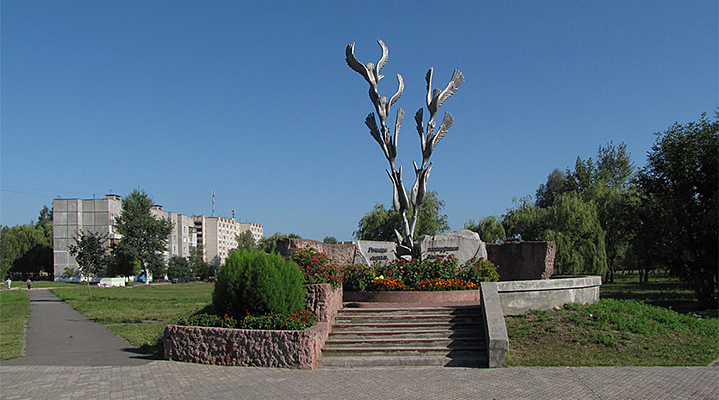
Rechitsa Sons Killed Far Away from Motherland Memorial stands on the Alley of Peacekeeping Soldiers. Seven storks with their wings folded hopelessly dive one after another into the rift between the granite stones. These birds embody the image of Rechitsa natives who have fallen in battle during various military conflicts far beyond the borders of their native country. First of all, it is about Afghanistan: according to the idea of the designers, the stone blocks are a symbol of Islamic fundamentalism. The monument is 7,5 meters tall. It stands in the center of a concrete platform. The project designer is Eduard Agunovich. The sculptural composition was made by Vladimir Slobodchikov.
Where: Park in Molodezhnaya Street
Aleksandr Isachev’s art gallery
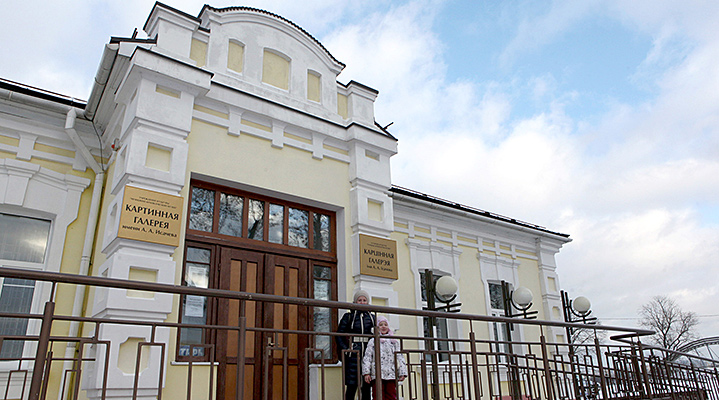
The fate of Aleksandr Isachev, one of the most mysterious artists of the 20th century Belarus, is connected with Rechitsa. The future artist was born in the village of Ozarichi, Kalinkovichi District, Gomel Oblast on 11 January 1955. He moved to Rechitsa with his mother at the age of three.
The talent of the painter manifested itself in childhood. Aleksandr received his first lessons in Mozyr, then in Minsk at a specialized school for gifted children. After four years of training he was expelled for violating the rules - he dyed his hair red. At the age of 18 Aleksandr Isachev left for Leningrad where he joined the community of avant-garde artists. Then his original style took shape in the technique of transparent painting.
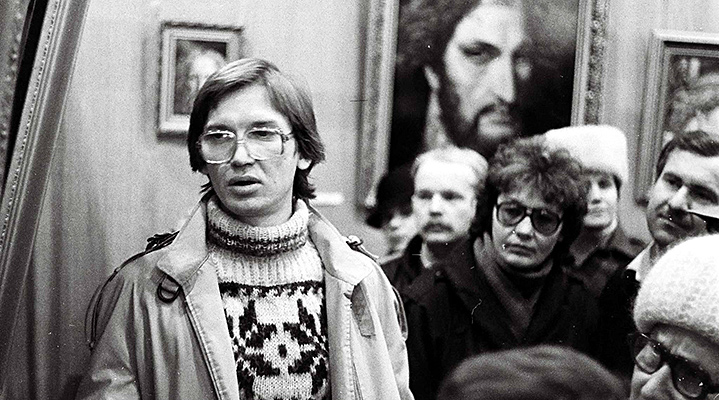
In addition to paintings and drawings Aleksandr Isachev painted icons and painted churches. In total, more than 500 works were made and many of them are now in private collections abroad.
Unfortunately, the artist lived for only 32 years: Aleksandr Isachev died right while working at his easel on 5 December 1987. His heart stopped...
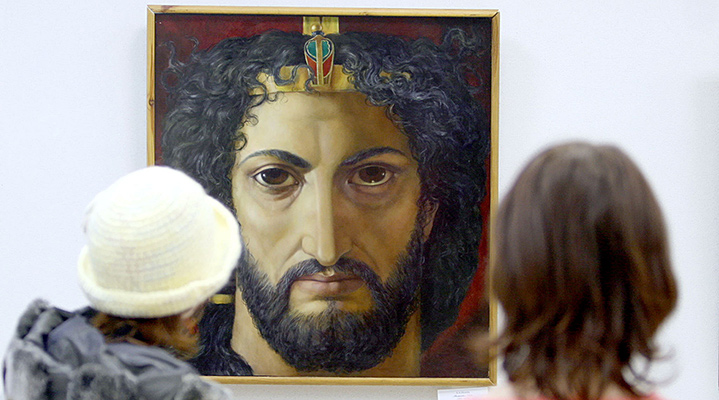
Almost a month before his death, an exhibition opened in Rechitsa where his works were shown to the public for the first time. The exposition aroused genuine interest among the town’s residents and attracted 20 thousand visitors. It meant recognition for the artist. Unfortunately, Aleksandr Isachev did not live to see continuation of his success in the capital city. After his death in May 1988, 32 paintings by the artist were exhibited in the Minsk Palace of Trade Unions. The exposition literally became a sensation - people spent many hours in queues to see unusual works with their own eyes. In total, more than 200 thousand people visited the exhibition.
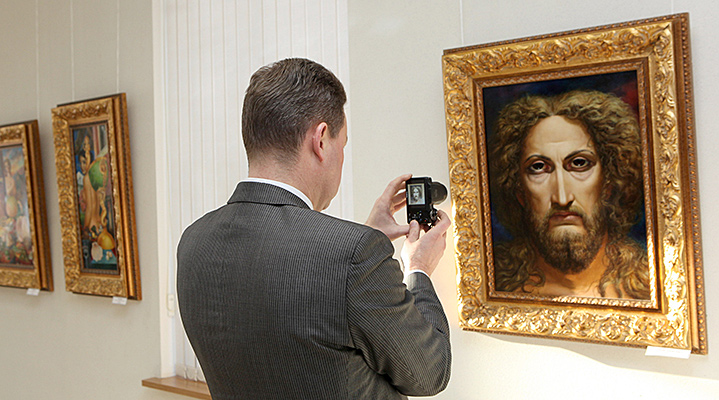
There are five paintings by Isachev in the public domain in Belarus today: "At the source", "Fortune-telling with a ball", "Teacher", "Magic" from the Vladyka series and "Andrew the First-Called". All canvases are originals and are in the permanent exhibition of the art gallery of the Rechitsa Local Lore Museum. The museum also has 30 graphic works on display. The gallery was named after Aleksandr Isachev in January 2015.
Where: 11 Naberezhnaya Street
Belorusneft’s museum
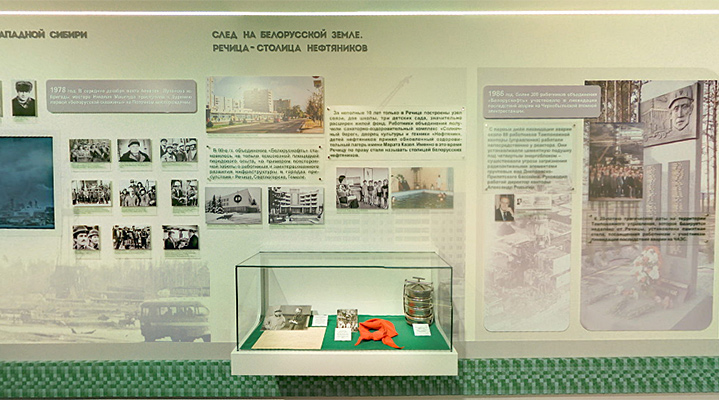
An oil field was discovered in the vicinity of Rechitsa more than half a century ago. The industrial group Belorusneft was established two years after this landmark event, in 1966. Nowadays the work of most of the city’s population is one way or another connected with the extraction of minerals. It was in Rechitsa that the history of the Belarusian oil industry began.
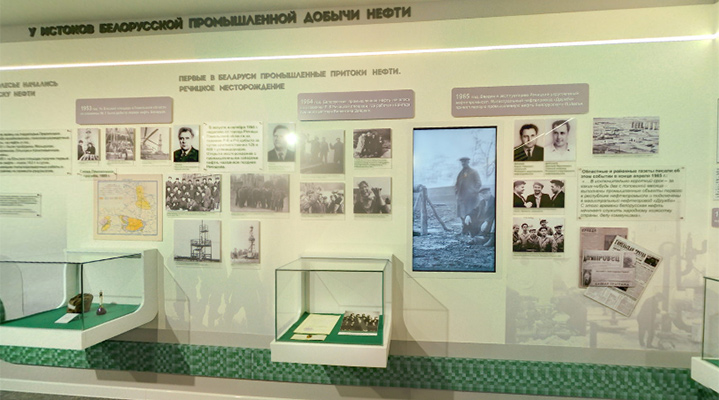
A gallery of labor glory of the enterprise was opened in 1998 in honor of the 100 millionth tonne of oil Belorusneft had extracted. It was located at the Neftyanik Palace of Culture and Technology. Over the years the museum was reconstructed three times. It was reconstructed the last time in honor of the 55th anniversary of the discovery of oil deposits near Rechitsa.
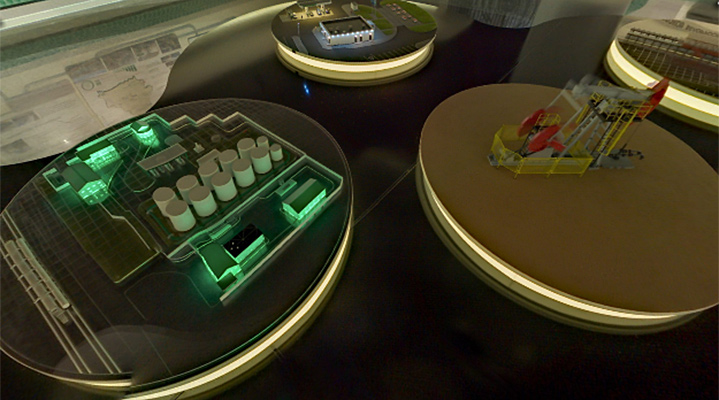
Today the gallery provides visitors with documents, photographs, miniature copies of various facilities of the enterprise: a drilling rig, a "rocking pump", a solar power plant (by the way, the largest in the country!), a gas station, and other ones. The premises of the Palace of Culture cannot accommodate all the exhibits accumulated over five decades. Therefore, many of them have been transferred to a virtual format and are shown on special multimedia panels.
Where: 38 Sovetskaya Street


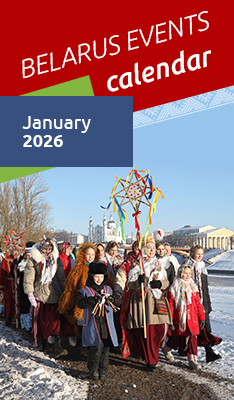




 print version
print version make home page
make home page add to bookmarks
add to bookmarks
